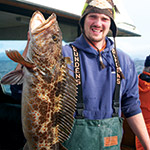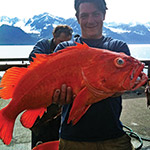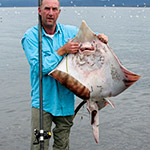There are several types of game fish in Alaska’s briny, including Pacific halibut, lingcod, rockfish, and salmon shark, and dozens of non-sporting kinds such as cod and flounder. Anglers experience good to excellent action virtually year-round but success tends to be more consistent during the warmer months, primarily from May into September. Although the main game species are not present in any large numbers to roadside anglers, those hiring a charter boat will have access to the best fishing grounds.
Southcentral Alaska has several coastal communities, most of which caters to a prolific fleet of recreational and commercial fishing boats. These communities serve as hubs for essentially all saltwater angling effort, from both shore and more remote locations only accessed by boat.
The primary ports include the towns of Homer and Seward on the Kenai Peninsula and Whittier and Valdez in Prince William Sound. Ninilchik and Anchor Point are two additional communities that offer limited ocean access on the peninsula.
Pacific Halibut
 Common Name: Halibut
Common Name: Halibut
General Timing: April into October
Typical Size: 10 to 60 pounds, up to 200 pounds
State Record: 459 pounds, 0 ounces
Best Areas: Exposed beaches, river mouths, shoals
Preferred Methods: Bait/surf-casting and deep sea jigging
Standard Gear: Heavy/very heavy rod/reel; 20- to 120-lb test
Top Tackle: Jigs and bait
The halibut is the premier target of anglers fishing Alaska’s coastal waters. Often very abundant, easy to catch, and a great food fish, the halibut is the perfect species to supplement a harvest trip or any other fishing experience.
Description: Largest species of flounder; somewhat elongated body, top side dark gray to dirty brown, bottom side white. The flesh is white and of firm texture. Average weight is 15 to 40 pounds with some of the better locations providing good opportunity for fish ranging from 60 to 100 pounds. Exceptional specimens between 300 and 350 pounds are boated every season and commercial fishers have documented catches up to 550 pounds.
Lingcod
 Common Name: Ling
Common Name: Ling
General Timing: July to November
Typical Size: 10 to 50 pounds, up to 75 pounds
State Record: 82 pounds, 6 ounces
Best Areas: Points, pinnacles, reefs, shoals
Preferred Methods: Bait/surf-casting and deep sea jigging
Standard Gear: Heavy/very heavy rod/reel; 20- to 80-lb test
Top Tackle: Jigs and bait
Next to halibut, lingcod is one of the larger bottom dwellers saltwater anglers are likely to encounter. Although not regularly targeted exclusively, they make for a perfect game species along with rockfish since both inhabit the same general structure. Typically very aggressive and of good size, fishing for them is both exciting and rewarding.
Rockfish
 Common Name: Snapper and bass
Common Name: Snapper and bass
General Timing: April to November
Typical Size: 2 to 10 pounds, up to 20 pounds
State Record: 38 pounds, 11 ounces
Best Area: Points, pinnacles, reefs, shoals
Preferred Methods: Spin/bait/surf-casting and deep sea jigging
Standard Gear: Heavy/medium rod/reel; 12- to 30-lb test
Top Tackle: Jigs and bait
Rockfish are very abundant along coastal waters in Southcentral. Erroneously labeled “snapper” and “sea bass,” rockfish is actually a family of fishes that consist of several dozen species in a vast variety of sizes and colors. Anglers generally encounter some 19 species of which only three or four make up the vast majority of sport catches. In Southcentral, the black rockfish is most common, followed by yelloweye, dusky, rougheye, and quillback.
Other Saltwater Species
 There is a vast number of saltwater species in Alaska, of which many are available to boaters as well as the roadside angler. Most readily available during the summer months when found in relatively shallow waters close to shore, the more common catches include one or more members of the cod and flounder families, greenling, and sculpin (Irish Lord). Some are more palatable than others with cod, pollock, greenling, yellowfin and starry flounder, and sablefish (black cod) being quite popular. Wolf eels and skates are caught too. Sharks are represented by several species of which a couple can be very plentiful, especially spiny dogfish, with salmon sharks locally abundant and a huge challenge on sport gear.
There is a vast number of saltwater species in Alaska, of which many are available to boaters as well as the roadside angler. Most readily available during the summer months when found in relatively shallow waters close to shore, the more common catches include one or more members of the cod and flounder families, greenling, and sculpin (Irish Lord). Some are more palatable than others with cod, pollock, greenling, yellowfin and starry flounder, and sablefish (black cod) being quite popular. Wolf eels and skates are caught too. Sharks are represented by several species of which a couple can be very plentiful, especially spiny dogfish, with salmon sharks locally abundant and a huge challenge on sport gear.


